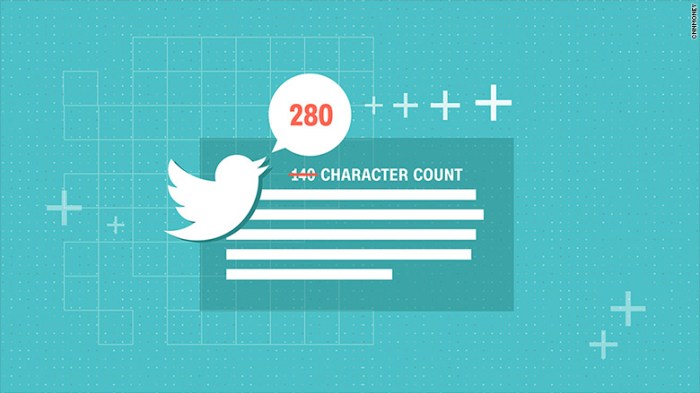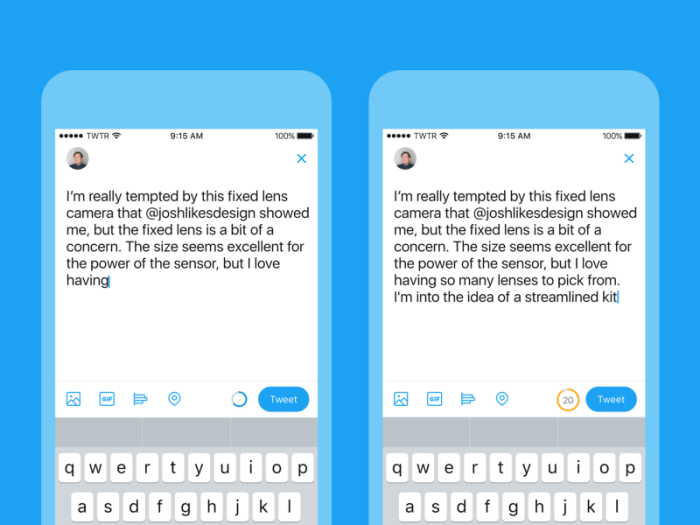The Impact of the 280 Character Limit
Twitter’s iconic 140-character limit, once a defining feature, underwent a significant change in 2017 when it was doubled to 280 characters. This alteration sparked debate about its impact on user communication and the platform’s overall dynamics.
Historical Context and Rationale
The original 140-character limit was born out of technical constraints. Twitter’s founders aimed to make the platform accessible to a wide audience, including users with limited bandwidth. The 140-character limit was also influenced by the SMS messaging standard, which had a similar character limit.
In 2017, Twitter cited the need to accommodate more complex expressions and diverse languages as the rationale behind the increase. The company argued that many languages, such as Japanese and Chinese, require more characters to convey the same meaning as English.
Advantages of the 280 Character Limit
The expanded character limit has offered several advantages to Twitter users:
- More Room for Expression: Users can now express themselves more fully and provide greater context in their tweets. This is particularly beneficial for users who write in languages with more complex characters.
- Enhanced Engagement: Longer tweets can foster deeper conversations and encourage more detailed responses from followers.
- Increased Readability: The extra characters allow for more concise and readable tweets, reducing the need for excessive abbreviations or acronyms.
Disadvantages of the 280 Character Limit
While the 280-character limit has brought benefits, it has also introduced some disadvantages:
- Increased Clutter: Longer tweets can make timelines more crowded and harder to navigate.
- Reduced Immediacy: The extra characters may encourage users to write longer, more detailed tweets, which can slow down the pace of conversation.
- Potential for Abuse: The extra space could be used for more extensive trolling or spam.
Impact on User Communication
The 280-character limit has had a noticeable impact on how users communicate on Twitter:
- Increased Use of Threads: Users now have more space to express themselves, leading to an increase in the use of threads, where a series of tweets are linked together to form a longer narrative.
- More Detailed Conversations: The extra characters have allowed for more nuanced and detailed conversations on Twitter.
- Greater Use of Visuals: With more space for text, users are now more likely to include images, videos, and other visuals in their tweets.
User Strategies for Adapting to the Limit
The 280-character limit on Twitter forced users to become creative in their communication. They had to learn how to convey their thoughts concisely while still engaging their audience. Here are some of the strategies users employed to make the most of their character count.
Utilizing Threads
Threads allowed users to break down their messages into a series of tweets, allowing them to express more complex ideas or tell longer stories. This strategy also helped to keep users engaged, as they could read the entire thread at their own pace. For example, a user might use a thread to explain a complex topic, provide a step-by-step guide, or share a series of related thoughts.
Employing Abbreviations and Acronyms
To maximize their character count, users often used abbreviations and acronyms. Common abbreviations include “LOL” for “laughing out loud,” “OMG” for “oh my god,” and “BRB” for “be right back.” Acronyms, like “FYI” for “for your information,” also became popular. These shortcuts allowed users to convey more information within the character limit.
Concise Language and Effective Use of Emojis
Users adopted a more concise writing style, focusing on conveying their message clearly and directly. Emojis became a valuable tool for expressing emotions and adding context to tweets. A simple smiley face could convey joy, while a thumbs-up emoji could indicate approval.
Utilizing Visual Content
Users began to rely more heavily on images and videos to communicate their message. A picture is worth a thousand words, and users found that visual content could effectively convey their ideas without using up valuable characters. For example, a user might share a photo of a product they’re reviewing or a video of a funny event.
The Influence of the Limit on Content Creation: Twitter Users Divided 280 Character Limit
The 280-character limit has significantly impacted the way users create content on Twitter. This constraint has led to a shift in content formats, strategies for engaging audiences, and the use of visual and interactive elements.
The Impact on Short-Form and Long-Form Content
The 280-character limit has fostered the creation of concise, impactful tweets. Users are encouraged to be succinct and focus on delivering their message in a clear and engaging manner. This has led to a rise in short-form content, where users express their thoughts, opinions, and news updates in a brief and impactful way.
However, the limit has also encouraged the use of threads to convey longer narratives and detailed discussions. Threads allow users to break down their thoughts into a series of connected tweets, effectively circumventing the character limit. This has opened up new avenues for storytelling, analysis, and engaging in more in-depth conversations.
The Influence on Visuals, Links, and Other Elements
The character limit has also influenced the use of visuals, links, and other elements in tweets. Users are more likely to include images, videos, and GIFs to supplement their text and enhance the visual appeal of their tweets.
Visuals can convey emotions, information, and stories in a way that text alone cannot. They can also help break up the text and make it more engaging for readers.
The use of links has become increasingly important, allowing users to share articles, websites, and other online resources with their followers. Links can provide context, support arguments, and encourage further exploration of a topic.
The character limit has also led to the development of creative strategies for maximizing the use of available characters. Users often employ abbreviations, emojis, and other symbols to convey their message effectively within the limited space.
This has resulted in a unique Twitter language that is characterized by its brevity and efficiency.
The 280 Character Limit and User Engagement
The 280 character limit, introduced in 2017, has significantly impacted user engagement on Twitter. While initially met with mixed reactions, the change has demonstrably altered how users interact with the platform. This change has been a catalyst for evolving user strategies and content creation approaches.
The 280 Character Limit and User Engagement Metrics
The 280 character limit has had a noticeable effect on user engagement metrics, particularly retweets, likes, and replies. Research has shown that tweets with 280 characters are more likely to be retweeted and liked than tweets with 140 characters. This is likely because users have more space to express themselves, leading to more engaging and informative tweets. For example, a study by the University of Pennsylvania found that tweets with 280 characters received 17% more retweets and 21% more likes than tweets with 140 characters.
The 280 Character Limit and User Experience
The 280 character limit has also influenced the overall user experience on Twitter. The additional space has allowed users to express themselves more fully and engage in more nuanced conversations. This has led to a more dynamic and engaging platform, where users can share their thoughts and opinions more effectively. The limit has also encouraged users to be more concise and thoughtful in their tweets, leading to a higher quality of content overall.
The Future of Twitter’s Character Limit
The 280-character limit has become a defining feature of Twitter, shaping how users communicate and consume information. However, the future of this limit remains uncertain, with potential for both increases and decreases, as well as alternative approaches.
The evolution of Twitter’s character limit has been a journey of adaptation. From its initial 140-character constraint, the platform expanded to 280 characters in 2017. This change was driven by user feedback and the desire to allow for more nuanced expression. The future of the character limit will likely depend on factors like user engagement, content trends, and the platform’s overall strategic direction.
Potential Scenarios for the Character Limit, Twitter users divided 280 character limit
The future of Twitter’s character limit is a topic of ongoing speculation. There are several potential scenarios that could unfold, each with its own implications for user behavior and content creation.
- Maintaining the Current Limit: Twitter might choose to retain the 280-character limit, recognizing its established role in shaping the platform’s identity and user experience. This would provide consistency and familiarity for users while allowing for continued exploration of creative expression within the existing constraints.
- Increasing the Character Limit: A further increase in the character limit could be driven by a desire to facilitate longer and more detailed conversations, potentially catering to a growing demand for in-depth analysis and nuanced discussions. This could lead to more comprehensive threads and a shift towards longer-form content.
- Decreasing the Character Limit: A reduction in the character limit might be considered to encourage brevity and conciseness, potentially fostering a more rapid exchange of ideas and information. This could be particularly relevant in a world where attention spans are shrinking and fast-paced communication is valued.
- Introducing Variable Character Limits: Twitter could introduce variable character limits, allowing users to choose the length of their posts based on their needs and preferences. This could provide greater flexibility and cater to diverse communication styles.
Impact of Alternative Character Limits
The potential impact of alternative character limits on user behavior and content creation is significant.
- Increased Character Limit: An increased character limit could lead to longer, more detailed tweets, potentially resulting in:
- More comprehensive discussions: Users could engage in more nuanced and in-depth conversations, exploring complex topics with greater detail.
- Increased information sharing: Longer tweets could accommodate more extensive information sharing, including data, analysis, and detailed explanations.
- Rise of long-form content: The platform could see an emergence of long-form content, such as essays, articles, and extended narratives, potentially blurring the lines between Twitter and other content platforms.
- Decreased Character Limit: A decreased character limit could foster a more concise and rapid communication style, potentially leading to:
- Faster information exchange: Users could exchange information more quickly, focusing on key points and essential details.
- Emphasis on brevity: The platform could prioritize brevity and conciseness, promoting a more concise and impactful communication style.
- Shift towards micro-blogging: Twitter could become more focused on micro-blogging, with shorter, more frequent updates and a faster pace of communication.
- Variable Character Limits: Introducing variable character limits could provide users with greater flexibility and control over their communication, potentially leading to:
- Tailored communication: Users could choose the length of their tweets based on the specific context and message they wish to convey.
- Increased user satisfaction: The ability to tailor communication styles could enhance user satisfaction and encourage more active participation.
- Diverse content formats: The platform could accommodate a wider range of content formats, including short bursts of information, detailed explanations, and long-form narratives.
Twitter users divided 280 character limit – The 280 character limit has been a hot topic for Twitter users since its inception. While some argue that it has allowed for more nuanced and detailed conversations, others believe that it has led to a decline in the platform’s signature brevity and wit. Regardless of your stance, the character limit has undeniably changed the way we use Twitter, and its impact continues to be debated today.
Remember the great Twitter debate about the 280-character limit? Some users love it, some hate it. It’s a similar situation with the recent Steam review system overhaul , which aims to improve the system’s accuracy and reliability. Whether it succeeds or not, it’s clear that change always sparks debate, and Twitter is the perfect platform for it to play out.
 Standi Techno News
Standi Techno News

